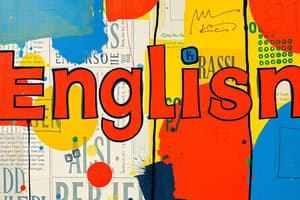Podcast
Questions and Answers
Which period of English language is characterized by the introduction of French and Latin?
Which period of English language is characterized by the introduction of French and Latin?
- Middle English (correct)
- Early Modern English
- Old English
- Modern English
What is the estimated number of words in the English language?
What is the estimated number of words in the English language?
- 100,000
- 150,000
- 200,000
- 170,000 (correct)
Which variety of English is characterized by its unique pronunciation and vocabulary features, influenced by its geographic location?
Which variety of English is characterized by its unique pronunciation and vocabulary features, influenced by its geographic location?
- Cockney (correct)
- Scottish English
- Indian English
- Received Pronunciation (RP)
What is the primary function of language in terms of cultural identity?
What is the primary function of language in terms of cultural identity?
Which English language feature is concerned with the study of sounds?
Which English language feature is concerned with the study of sounds?
What is the name of the English epic poem written during the Anglo-Saxon period?
What is the name of the English epic poem written during the Anglo-Saxon period?
Flashcards are hidden until you start studying
Study Notes
History of English
- Origins: Germanic languages, influenced by Latin, Greek, and French
- Old English (5th-11th centuries): Anglo-Saxon period, Beowulf, and epic poetry
- Middle English (11th-15th centuries): Norman Conquest, introduction of French and Latin, Canterbury Tales
- Early Modern English (15th-17th centuries): Renaissance, introduction of Greek and Latin, King James Bible
- Modern English (17th century onwards): British Empire, American English, globalization
English Language Features
- Phonology: 44 consonant and vowel sounds, stress patterns, and diphthongs
- Morphology: inflectional and derivational morphology, prefixes, suffixes, and compounding
- Syntax: SVO word order, verb tenses, modality, and clause structure
- Vocabulary: 170,000+ words, borrowings from other languages, and neologisms
English Dialects and Varieties
- Regional dialects: Received Pronunciation (RP), Cockney, Estuary English, Scottish, Welsh, and Irish English
- Social dialects: sociolects, jargon, and slang
- International varieties: American English, Australian English, Canadian English, and Indian English
English Language Functions
- Communication: spoken and written communication, dialogue, and discourse
- Creativity: literature, poetry, and storytelling
- Information: news, media, and education
- Identity: cultural identity, language and culture, and language attitudes
History of English
- English originated from Germanic languages and was shaped by influences from Latin, Greek, and French.
- Old English (5th-11th centuries) marked the Anglo-Saxon period, notable for the epic poem Beowulf.
- Middle English (11th-15th centuries) emerged post-Norman Conquest, integrating French and Latin vocabulary, with works like the Canterbury Tales.
- Early Modern English (15th-17th centuries) developed during the Renaissance, introducing many Greek and Latin terms, particularly seen in the King James Bible.
- Modern English (17th century onwards) evolved alongside the British Empire, saw the rise of American English, and was impacted by globalization.
English Language Features
- Phonology consists of 44 consonant and vowel sounds, alongside distinctive stress patterns and diphthongs.
- Morphology involves inflectional and derivational processes, incorporating prefixes, suffixes, and compounding to form new words.
- Syntax predominantly follows a Subject-Verb-Object (SVO) order, encompassing various verb tenses, modality, and clause structures.
- Vocabulary boasts over 170,000 words, enriched through borrowings from other languages and the creation of neologisms.
English Dialects and Varieties
- Regional dialects include Received Pronunciation (RP), Cockney, Estuary English, as well as Scottish, Welsh, and Irish English, each with unique features.
- Social dialects consist of sociolects, specialized jargon, and forms of slang that reflect social identity and context.
- International varieties include distinct forms like American English, Australian English, Canadian English, and Indian English, each shaped by regional influences.
English Language Functions
- Communication is achieved through both spoken and written forms, including dialogue and discourse analysis.
- Creativity is expressed through literature, poetry, and the art of storytelling, showcasing the adaptability of the language.
- Information dissemination occurs via news outlets, media, and educational resources utilizing English.
- Identity is reflected through cultural contexts, linking language to cultural heritage and societal attitudes towards it.
Studying That Suits You
Use AI to generate personalized quizzes and flashcards to suit your learning preferences.



